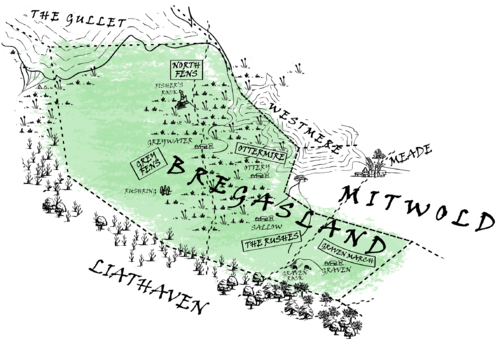Bregasland
Overview - "The Dour Fens"
Sandwiched between the barbarian-held woods of Liathaven and the sea lies Bregasland, an area comprising partially of fenland leading to the coast. Home to “Bregas” (fenlanders), this is a place of small islands of abundantly fertile soil, surrounded by seemingly endless marshes where eels are caught. There are several households here made up entirely of merrow, and several settlements populated by people who have been shunned but cannot bring themselves to leave the Marches.
Bregasland is home to partially sunken ruins, including several stone circles that pre-date Marcher possession of the land. For some reason the marshwalkers that are comparatively common in the marshes tend to leave these ruined structures alone. It is also home to dangerous man-eating lizards, giant insects, flesh-eating plants, bottomless bogs and strange lights that seek to lure the incautious into deadly situations. Those who explore the depths of the marshes here sometimes disappear without trace ...
Recent History
Since the Jotun took Liathaven there has been an increase in raiding along the southern borders of Bregasland. Many residents are concerned that the barbarians will launch a major assault through the Rushes and Gravenmarch. While Bregasland has several forts and castles, they are generally small and mostly located along the western borders; building a major fortification is hampered by the boggy ground.
Major Features
Graven Rock
This enormous smooth flat grey-stone plateau approximately 4 miles in each direction, extends from the ground with a gently sloping face of only fifty metres or so. From a great height it has the appearance of a large flat pebble buried in the ground with only its upper level surface exposed. This unusual stone deposit sits in some of the largest expanses of dry, fertile territory in Bregasland, in the region of Gravenmarch. The outer surface of the rock is covered in various entrances and doorways, which are the evidence of many hundreds of years of mining and excavation of the rock’s rich mineral core. The ore deposits are largely played out today, but there are still mine workings beneath Graven Rock that are in use. It stands near the town of Graven, one of the largest settlements in Bregasland, and contributed directly to the wealth of the citizens there. Shortly before the Spring Equinox 381YE, work was completed in one of the deeper caves to create a sinecure that provides mana to the Keeper of the Dour Fens.
Ottery
A small fishing port that trades the produce of the marshes to Meade and across the Westmere to Wintermark.
Sallow
People here keep themselves to themselves to a degree found off-putting even by other Bregaslanders. If those who don’t know press friendship on Sallowfolk, long knives come out and many’s the Sallow-cut who can tell you it’s best not to pry. The people of Sallow deal in cutting and drying rushes that are shipped to the other towns of the Marches for roofing.
Rushring
A partially-submerged stone circle, the notorious site of a number of ritual killings in 365YE.
Regions
Gravenmarch
Sometimes called "the only dry spot in Bregasland", Gravenmarch borders Mitwold, Mournwold, and Liathaven. The soil here is fertile, and the gentle eastern hills and well-irrigated western fields are dotted with farms, villages, and hamlets. The largest settlement in Bregasland, the town of Graven is found here, in the shadow of Graven Rock. The town grew rich from a combination of high fields and the mineral wealth extracted from the Rock. In happier times Navarr merchants and stridings regularly passed through on their way north from Liathaven, with news and trade-goods from far afield. As with many parts of Bregasland, the people of Graven have a reputation for being odd - but in this case it is due to the number of them who started their lives far away and were brought here by a Navarr quide. Today, Graven is known for the good quality stone it supplies to construction efforts across the Marches, and for the garrison that keeps a wary eye on the orcs of the forest and the Mourn.
Keyword: Unlike the rest of Bregasland, Gravenmarch does not have the marsh quality.
Grey Fens
Keywords: Marsh
North Fens
To the west of North Fens lie the southern Jotun kingdoms, while its northern border runs along the southern coast of the Gullet. The shore is scattered with small fishing villages. As one travels west, each village is said to be a little more insular until the westernmost villages and farms of North Fens are said to border on the xenophobic. North Fens is the site of Fisher's Rock.
The largest settlement in North Fens is Greywater, which is said to mark the furthest west that any wise Marcher will go. The locals make their living primarily from eel-fishing, but since this isn’t a trade that leads to many exports, some of the more daring among them will scour the surrounding marsh for unusual plants and flowers. These are dried, and sold through the markets at Meade for study across the Empire. The small town takes its name from slip clay stirred up by frequent storms: it’s not the best water to drink. A thriving market in pure water exists here, with fresh water from the estuary left to settle in vast oak tanks and then carefully decanted. "Too poor to drink water" is a local phrase applied to the truly destitute, who are forced to drink dirty water.
Keywords: Marsh, Coastal
Ottermire
Keywords: Marsh
The Rushes
Keywords: Marsh
OOC Notes
- All the regions of Bregasland are under Imperial control
